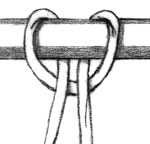You are using an out of date browser. It may not display this or other websites correctly.
You should upgrade or use an alternative browser.
You should upgrade or use an alternative browser.
Oh why knot?
- Thread starterderekleffew
- Start date
I would say that the first knot it a barrel knot. It is also commonly used for the safety knot in a climbing system. Here is one attached to my water bottle. The one on my water bottle has fewer wraps but is the same knot. The second picture is two of them tied against each other on a rope to make a loop.
View attachment 10677 View attachment 10678
The second knot in this thread is a larks head, a similar knot with more wraps is called a prusik. To tie this I used the loop from picture two. The first picture is before the knot was tightened and the second is after I pulled on the loop. This knot is great because when under tension it doesn't slip but when loosened it is easy to move a long the line. I have used this knot to hang a 1/2" x 350' steel zip line cable on a high ropes course and also to relieve strain on cable connectors.
View attachment 10679 View attachment 10680
When using this knot for strain relief I usually tie the prusik on the cable below the connector, then tie the prusik loop off on a baton or something else near by that can take the pressure. I could take a picture of this if anyone wants to see. Does anyone think it's a bad idea if I am working with power cables? What about other kinds of cable? Obviously cable pressure should be avoided but I figure pressure like this is better than pressure on the connectors.
If you do use the double fishermans knot to tie a prusik or a cordelette, PLEASE leave a decent tail. This knot does slip a little as it tightens, especially with tech cords. It is a very efficient knot, though. alternative, Webbing has a lot of similar uses too even in theater/entertainment for strain reliefs and such, but only tie water knots in webbing.
jhochb
Active Member
Good Morning All
i find this site yery interesting
I go there with a lenth of rope & practice
Animated Knots by Grog | How to Tie Knots | Fishing, Boating, Climbing, Scouting, Search and Rescue, Household, Decorative, Rope Care,
have fun
be careful
ask questions
i find this site yery interesting
I go there with a lenth of rope & practice
Animated Knots by Grog | How to Tie Knots | Fishing, Boating, Climbing, Scouting, Search and Rescue, Household, Decorative, Rope Care,
have fun
be careful
ask questions
afreeradical
Member
This is what I call a proper cable tie
You Must start with a piece of Cotton Twill ( Have tried many types of cord, rope, synthetic twill ect..... )
Tie a clove hitch and finish with a half hitch
In the heat of Hang and Focus,
If I can remove it or slide it
I or someone else will.
If you do it to 1 you'll do it to another
AND You WON'T have time to fix it on the OUT like you told yourself you would.
Then it will cost you time and money on the Next IN....
The cotton twill is a little bit more expensive but it's more durable, washable and softer on the hands which is very important when cabling for days at a time....
(sorry pic's uploaded so big.. I resized on phone and said was 240x480 but obviously they not )
Interesting I haven't heard that one. As was mentioned above, I know it as a Lark's Head. I wonder if that's some sort of regional slang.i believe its called a cow hitch
Here's a theory: if the knot is made by making a bight, passing over the pipe, then pulling the ends thru, it's a larks head. If it's made with a free end, it's a cow hitch (see Grog's Animated Knots). Wikipedia indicates that cow hitch came first, but I'd never heard it called that until today.
Sent from my iPad5 using Tapatalk
Sent from my iPad5 using Tapatalk
cmckeeman
Active Member
And if it is done with webbing it then turns into a girth hitch, And if you pass it through two more times it then becomes a prussik...Here's a theory: if the knot is made by making a bight, passing over the pipe, then pulling the ends thru, it's a larks head. If it's made with a free end, it's a cow hitch (see Grog's Animated Knots). Wikipedia indicates that cow hitch came first, but I'd never heard it called that until today.
Sent from my iPad5 using Tapatalk
Latest evolution of the film industry's "sash cord knot covered with friction tape":


This was on a 50' cable of 12/3 SJOOW with 5-15 ends. Interestingly, near each end was a shop-made label stating
SJO stinger (extension cord) for use on a stage or studio?
I've seen "cable bullets" on 4/0 feeder and Socapex before, but never ones small enough for SJO.

This was on a 50' cable of 12/3 SJOOW with 5-15 ends. Interestingly, near each end was a shop-made label stating
Warning:
1. Do not use while coiled.
2. Do not use when submersed or wet.
3. Maximum rating is 15 amps.
SJO stinger (extension cord) for use on a stage or studio?
I've seen "cable bullets" on 4/0 feeder and Socapex before, but never ones small enough for SJO.
Similar threads
- Replies
- 7
- Views
- 382
- Replies
- 16
- Views
- 2K
- Replies
- 21
- Views
- 6K
- Replies
- 9
- Views
- 492
Users who are viewing this thread
Total: 1 (members: 0, guests: 1)



